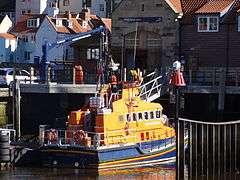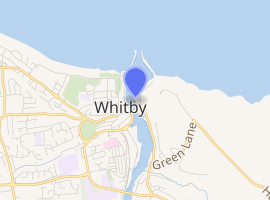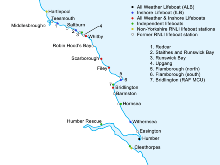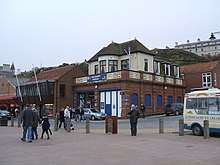Whitby Lifeboat Station
Whitby Lifeboat Station is a Royal National Lifeboat Institution RNLI lifeboat station located in Whitby, North Yorkshire, England. It is one of nine situated along the Yorkshire coast[1] and is home to both an All-Weather Lifeboat (ALB) and an Inshore Lifeboat (ILB). A lifeboat station has been in existence in Whitby since 1802, with responsibility for the lifeboats being part of the RNLI since 1861. In its 200 plus year history, Whitby has had five different lifeboat stations (although not all operated at the same time). A sixth lifeboat and station was located at Upgang, just up the coast from Whitby, and whilst it was considered separate from Whitby, it was crewed by men from the Whitby lifeboat.
| Whitby Lifeboat Station | |
|---|---|
 | |
 Whitby Lifeboat Station | |

| |
| General information | |
| Type | RNLI Lifeboat Station |
| Location | Whitby, North Yorkshire |
| Country | England |
| Coordinates | 54.4881°N 0.6130°W |
| Opened | 2007[note 1] |
| Cost | £1 million |
| Owner | Royal National Lifeboat Institution |
| Website | |
| Official webpage | |
The present day station and its two lifeboats, cover a huge swathe of the northern coast from the Humber to Hartlepool, and is regularly listed as the busiest in the north of England.[2] The station has two lifeboats; the All-Weather Lifeboat George and Mary Webb and the Inshore Lifeboat Warter Priory.[3]
History
The first lifeboat to be stationed at Whitby was in 1802 on the west side of the river.[4] This had been paid for by a combination of local finance and an offer from Lloyds of London who contributed £50 of the £160 needed for a lifeboat.[5] In 1822 an east side station was opened and also in 1865 another in Upgang; by the end of the 1865, Whitby had four lifeboats under the command of the harbour master.[6] Two of these were the Upgang Lifeboats, which were housed on a stretch of beach at Upgang, 1 mile (2 km) up the coast towards Sandsend.[7] The RNLI always regarded Upgang as being a different lifeboat station, despite its proximity to Whitby,[8] and the fact it was crewed by the men from the Whitby station.[9]
The lifeboat stations in Whitby are detailed as follows;[10]
| Name | Opened | Closure | Location | Notes |
|---|---|---|---|---|
| Whitby West Pier | 1802 | 1847 | West side of the river | Closed when the Khyber Pass was cut in the town,[note 2][11] so the lifeboat house was moved further south (now the site of the Lifeboat museum)[12] |
| Whitby East Pier | 1823 | 1863 | East side of the river (by the old East Pier) | |
| Upgang | 1865 | 1919 | Upgang was located a little to the west of Whitby | After closure, the boat at Upgang was transferred to Whitby |
| Whitby Landward Pier | 1847 | 1957 | On the west side of the river, opposite the Old East Pier | Now the Whitby Lifeboat Museum |
| Whitby (Motor) | 1919 | 2006 | Closed and razed to the ground in 2006; new lifeboat station built on the same site | |
| Whitby | 2007 | East bank of the river in Whitby Harbour | Built on the site of the former 1919 Motor boat lifeboat station |
The lifeboat stations have always been in different locations in Whitby on the mouth of the River Esk; between 1822 and 1863, it was located on the original East Pier on the east bank of the river.[13] The present day lifeboat station is also on the east side of the river (further upstream) and was opened in 1919,[14] although another building housed a second lifeboat on the west side of the river between 1895 and 1957.[15] This building has since been re-opened as the Whitby Lifeboat Museum.[16]

The lifeboat disaster of 1861, where twelve of the lifeboatmen died, prompted a local fund-raising effort for the widows and children of those who died. This eventually raised over £8,000, but the trustees of the money thought that supplying the money to the widows and orphans of the disaster might give them ideas above their station, so a grand memorial was paid for instead to be installed in the parish Church of St Mary in the town.[17] Soon after the tragedy, the local lifeboat committee agreed to the RNLI taking over responsibility for the Whitby lifeboats.[18]
In 1881, a ship foundered during a heavy snowstorm in Robin Hood's Bay. The lifeboat stationed in that village was deemed to be unseaworthy and so a telegraph was sent to launch the Whitby lifeboat, the Robert Whitworth. Due to the heavy seas, this had to be taken over land through blizzards and snowdrifts. A similar situation occurred in April 1834, when the lifeboat from Whitby was carried overland to Robin Hood's bay to rescue two women in difficulty.[19]
The sinking of the Rohilla in 1914 was attended by six lifeboats in all, but the motorised lifeboat from Tynemouth was the only one that could get near to the Rohilla due to the swell and the pull of the waves on the other lifeboats which were using oars. After this, most RNLI crews were persuaded about the efficacy of using motorised boats over ones with oars; previously, a lot of the crews were suspicious about the motorised lifeboats.[20] The first motorboat delivered to Whitby was the Margaret Harker-Smith in 1919. She only had a single engine and so was fitted sails and additionally had the capacity for men to row her with oars.[21]
Despite this, Whitby retained a rowing lifeboat until 1957 (the Robert and Ellen Robson), which was the last rowing boat to be officially operated by the RNLI.[22] This boat is now on display in the RNLI museum in Whitby.[23]
In 1966, the first Inshore Lifeboat (ILB) was launched at Whitby. The ILB is useful for rescues where the all-weather lifeboat has difficulty getting to.[24]
On 7 September 2007, the Duchess of Kent formally unveiled a new £1 million lifeboat station in Whitby.[25] The new station was built on the site of the old motor lifeboat station (built in 1918 and in use since 1919), which had become life-expired but was known to the crews as the Tin Shed.[26] Whilst the new lifeboat station was being constructed, the old No 1 lifeboat station, now the museum, was resurrected as the lifeboat house for one year from 2006 to 2007.[27]
In 2018, two crew members from Whitby were sacked after a picture of a fellow crew member was superimposed upon a pornographic image. This doctored photo was then printed upon a mug that one of the crew members kept on the boat. Despite heavy criticism from those sacked, as well as supporting parties, the RNLI upheld the dismissals after an appeal.[28]
Notable incidents
Between 1802 (when the first lifeboat was launched at Whitby) and 2009, 24 lifeboat crew members have been lost from Whitby. Their names are commemorated in the RNLI memorial at Poole in Dorset.[29]
Lifeboat disaster (1841)
On 6 October 1841, the east-side lifeboat was on her way to the rescue of two yawls foundering in Whitby Bay. The lifeboat capsized and four lifeboatmen lost their lives.[12][14]
.jpg)
Attribution: Frank Meadow Sutcliffe and The Sutcliffe Gallery
Lifeboat disaster (1861)
On 9 February 1861, a severe storm struck the east coast of England which resulted in 200 ships being wrecked.[30] The crew had already been out and responded to five ships in distress, when responding to the sixth, a huge wave capsized their vessel.[31] The only survivor of the incident was Henry Freeman who was also the only member of the crew who was wearing a cork lifejacket at the time; the other crew members were wearing their traditional ballast filled lifebelts.[note 3][18] The other twelve lifeboat crewmen, were drowned.[32]
Agenoria (1877)
The schooner Agenoria which was transporting coal from Hartlepool to Whitby ran aground just outside Whitby harbour on 10 January 1877. The Whitby lifeboat Harriet Forteath launched to try and effect a rescue.[33] During the swell, she capsized and all but one of her 12 crew were thrown into the water. One swam ashore, seven got back into the vessel, but three members of the RNLI crew died by drowning, with their bodies washing up on the beaches around Whitby in the following days.[34][35]
The Visitor (1881)
The brig Visitor foundered in the bay of Robin Hood's Bay in November 1881, and after the hold was flooded with 5 feet (1.5 m) of water, the crew abandoned ship into their lifeboat.[36] The Robin Hood's Bay RNLI lifeboat station had been closed in 1855, and the unofficial lifeboat in the village was deemed "unseaworthy"[note 4] and so a telegraph was sent to launch the Whitby Lifeboat. The seas were too rough to launch from Whitby and row around the coastline, so a decision was made to haul Robert Whitworth the 6 miles (9.7 km) overland to Robin Hood's Bay through blizzards and snow drifts, some as deep as 7 feet (2.1 m). This took two hours to achieve using the combined strength of 18 horses and 200 men.[37] When the lifeboat and crew arrived, they launched the boat and spent 90 minutes in effecting a rescue of the people still stranded at sea. All survived and a commemorative plaque now memorialises the rescue in the village of Robin Hood's Bay.[38][39]
The events of The Visitor prompted the RNLI to re-open the lifeboat station at Robin Hoods Bay (until 1931).[40]
SS Rohilla (1914)
Rohilla was launched in 1906 for the British India Steam Navigation Company. She was pressed into war service in 1914 as HMHS Rohilla (His Majesties Hospital Ship). Whilst sailing from the Firth of Forth to Dunkerque to evacuate wounded soldiers, she ran aground on Saltwick Nab reef, which is just south of Whitby Harbour. Despite being only a short distance from the shore, high seas and gale force winds prevented a successful rescue from the beach, although the Whitby RNLI contingent did try one by hauling their boat over an 8 feet (2.4 m) wall, then lowering it down the 200-foot (61 m) cliff before launching from the beach opposite the wreck.[41][42][43]
In all, six lifeboats were launched to try and rescue the 229 people on board over the course of three days. During the grounding of the vessel, she broke her back and several attempts were made to safely remove those onboard. In all, 83 people died in the sinking. Of the six lifeboats launched, only two were motorboats, and because of the perilous waves, only the motorboats could get close enough to rescue survivors. This prompted lifeboat crews to demand motorised rescue vessels and spelt the end for the traditional rowing boat.[20][44]

Ruswarp flood (1931)
The Whitby Lifeboat was again taken overland to the village of Ruswarp (further upstream of Whitby on the River Esk) in September 1931 due to extreme flooding. The flooding had washed away several bridges and the lifeboat was needed to rescue people from their houses.[45] Despite the narrowness of the walls on the roads and the extreme current, the lifeboat crew (in No. 2 Lifeboat) managed to rescue five people.[46][47]
Admiral Von Tromp (1976)
On 30 September 1976, the trawler, Admiral Von Tromp, ran aground on Saltwick Bay rocks, much as the Rohilla had done 62 years earlier. The trawler had set sail from Scarborough the day before and was going fishing in an area some 45 nautical miles (83 km; 52 mi) north east of Scarborough. Why the boat ran aground some 90 degrees off of her pre-planned course has never been fully explained as the man at the helm of the ship drowned that night. The Whitby Lifeboat was launched and made several attempts to get the men off the stricken boat, but to no avail, even though at one point, the two boats were touching. Eventually, the flooding of the ship led the men to taking to open water from which three were washed ashore, with the skipper of the boat being rescued by the inshore lifeboat from the sea. Two of the trawler men died. At a resultant inquiry, a nautical surveyor stated that even if the boat had been left to its own devices, she would not have been taken upon the rocks by the tide. Two of the RNLI crewmen were awarded medals for the mission.[48][49]
Fleet
| Dates in service | Class | ON[lower-alpha 1] | Op. No.[lower-alpha 2] | Name | Comments |
|---|---|---|---|---|---|
| 1881–1870 | Lucy | [50] | |||
| 1870–1881 | Lucy (1870–1871), Robert Whitworth(1871–1881) | First named Lucy, later named Robert Whitworth. Original boat named Robert Whitworth served at Bridlington and was wrecked in the Great Gale of 1871.[51][50][lower-alpha 3][52] | |||
| 1872–1879 | Harriet Forteath | [50] | |||
| 1879–1881 | Harriet Forteath (II) | [50] | |||
| 1881–1887 | Harriet Forteath (III) | ||||
| 1887–1895 | 114 | Christopher | [50] | ||
| 1882–1908 | 180 | Robert and Mary Ellis | [53] | ||
| 1895–1914 | 379 | John Fielden | Damaged beyond repair during the SS Rohilla rescue effort. Despite rescuing several people, the John Fielden broke in two on the rocks of Saltwick Nab.[54] | ||
| 1908–1934 | 588 | Robert and Mary Ellis (II) | [50] | ||
| 1909–1931 | Rubie-class | 594 | William Riley | A self-righting boat, she was initially allocated to Upgang, but after only two rescues, was allocated to Whitby. After retirement from the RNLI, the boat saw many uses, with rumours of involvement in the Dunkirk evacuation.[55] | |
| 1919–1938 | Margaret Harker-Smith | Paid for by public donation but named after the lady who bequested a large sum of money for her. The boat was the first motorboat launched at Whitby as a direct response to the Rohilla disaster.[56][57] | |||
| 1931–1938 | 580 | Jacob and Rachael Vallentine | [50] | ||
| 1938–1941 | 522 | Richard | [50] | ||
| 1938–1957 | Mary Ann Hepworth | After withdrawal from RNLI service, the Mary Ann Hepworth was used as a pleasure cruiser up and down the River Esk and also out to sea from Whitby Harbour.[56] | |||
| 1947–1957 | 669 | Robert and Ellen Robson | Built in 1918,the Robert and Ellen Robson served at Tramore and Aberdeen, before spending ten years at Whitby before being retired from active service.[22][58] | ||
| 1974−1988 | Waveney-class | 1033 | 44-012 | The White Rose of Yorkshire | Transferred to Invergordon in 1988.[59][60] |
| 1988–1996 | Tyne-class | 1131 | 47023 | City of Sheffield | [61] |
| 1988–1997 | D-class | D-369 | Unnamed | [62] | |
| 1996– | Trent-class | 1212 | 14-14 | George and Mary Webb | [63] |
| 2005–2007 | D-class | D-503 | Criddy and Tom | ||
| 2007– | D-class | D-512 | Jane Ann II | ||
| 2007–2017 | D-class | D-674 | OEM Stone III | An Inshore Lifeboat (ILB), she was unveiled and named by the Duchess of Kent at the re-opening of Whitby's new lifeboat station in 2007[26] | |
| 2017– | D-class | D-810 | Water Priory | [64] |
|
|
Notes
- The present station is built on the site of the former Motor Boat Lifeboat station that was first built in 1919.
- The Khyber Pass was cut out of the West Cliff at the behest of George Hudson who built the Royal Crescent at the top of the cliff. The road curves 180 degrees and rises up the hill before curving another 180 degrees back on itself to access the cliff top.
- The story is that the captain of the lifeboat, Jon Storr, had given the new type lifebelt to Henry Freeman as he was the youngest crew member. The other crew members wore their traditional life belts filled with ballast. The new life jacket had been sent out to all local lifeboat stations by the RNLI in an effort to persuade them to become part of a nationally supported organisation which it would be hoped would be better resourced and staffed.
- Some reports described the boat as being rotten.
References
- "Mayday... Ride for the Lifeboats! » Northern Life". Northern Life Magazine. 7 March 2016. Retrieved 8 February 2019.
- "Heroes of the cruel sea struggle to find lifeline for the future". The Yorkshire Post. 18 September 2010. Retrieved 9 February 2019.
- "Whitby's lifeboats". rnli.org. Retrieved 8 March 2019.
- "Nostalgia on Tuesday: Brave Tradition". The Yorkshire Post. 2 May 2017. Retrieved 9 February 2019.
- Chrystal 2012, p. 42.
- "Genuki: WHITBY: Geographical and Historical information from the year 1890., Yorkshire (North Riding)". www.genuki.org.uk. Retrieved 8 February 2019.
- Dibdin & Ayling 1894, p. 183.
- "Annual Report". The Lifeboat. Poole: RNLI. 11 (116): 21. May 1880. ISSN 0024-3086.
- Leach 2018, p. 116.
- "Rapid Coastal Zone Assessment Survey, Yorkshire to Lincolnshire; Whitby to Reighton" (PDF). historicengland.org. English Heritage. p. 35. Retrieved 14 February 2019.
- "Point 9 - Royal Crescent". BBC News. 29 September 2006. Retrieved 7 March 2019.
- White 1993, p. 81.
- "Tate Hill Pier, Whitby, North Yorkshire | Educational Images | Historic England". historicengland.org.uk. Retrieved 8 February 2019.
- "Station History | RNLI". rnli.org. Retrieved 8 February 2019.
- "Whitby Lifeboat Museum - Visit Our RNLI Museums". rnli.org. Retrieved 8 February 2019.
- "Major award for Whitby lifeboat museum's Pete". The Whitby Gazette. 3 June 2013. Retrieved 8 February 2019.
- Taylor, John Russell (2014). The second wave : British drama for the seventies (2 ed.). London: Routledge. p. 122. ISBN 978-0-415-72790-7.
- "Disaster service to remember lifeboat heroes". The Yorkshire Post. 7 February 2011. Retrieved 8 February 2019.
- Lloyd, Chris (28 August 1999). "Come hell or high snowdrift, we'll save their souls". Northern Echo. ProQuest 328877089.
- Potts, Lauren (30 October 2014). "Three-day WW1 sea rescue remembered". BBC News. Retrieved 8 February 2019.
- Leach 2018, p. 31.
- "Museum resumes its role as a lifesaver after nearly 50 years". The Yorkshire Post. 20 September 2005. ProQuest 335230525.
- Lavery, Brian (2005). The island nation : a history of Britain and the sea. London: Conway Maritime. p. 165. ISBN 1-84486-016-7.
- Barnard, Ashley (5 July 2016). "Lifeboat crew members past and present meet for 50th anniversary event for celebrate 50 years of Whitby's inshore lifeboat". The Northern Echo. Retrieved 9 February 2019.
- Foster, Mark (7 September 2007). "Duchess declares lifeboat station open". The Northern Echo. Retrieved 9 February 2019.
- "Lifeboat station's big day". The Whitby Gazette. 11 September 2007. Retrieved 9 February 2019.
- "Whitby Station History | RNLI". rnli.org. Retrieved 9 February 2019.
- "Lifeboatmen sacked over pornographic mugs accuse RNLI of conducting a 'witch hunt'". The Telegraph. 12 June 2018. Retrieved 9 February 2019.
- "New memorial to honour lifeboatmen who lost lives". The Whitby Gazette. 10 February 2009. Retrieved 8 February 2019.
- "Services to mark lifeboat disaster". The Scarborough News. 3 February 2011. Retrieved 8 February 2019.
- "Lifeboatman who survived against the odds - thanks to his new lifejacket". The Northern Echo. 9 February 2017. Retrieved 8 February 2019.
- "Lifeboat disaster to be commemorated". Whitby Gazette. 11 January 2011. Retrieved 8 February 2019.
- Stanway, Kate (1909). Britannia's Calendar of Heroes. London: G Allen & Sons. p. 13. OCLC 5957418.
- "Shipping Casualties and Loss of LIfe". The Hampshire Telegraph and Sussex Chronicle (4, 634). Col E. 13 January 1877. p. 8. OCLC 173729645.
- "The Whitby Lifeboat Accident". The Leeds Mercury (12, 095). Col F. 15 January 1877. p. 3. OCLC 751697369.
- Historic England. "Visitor (1368757)". PastScape. Retrieved 10 February 2019.
- Wilson, Natalya (16 January 2013). "Author tells fascinating history of lifeboats". York Press. Retrieved 13 February 2019.
- "RNLI wants help to remember famous rescue". The Yorkshire Post. 22 May 2008. Retrieved 13 February 2019.
- "Epic rescue depicted in artist's painting". The Whitby Gazette. 9 January 2009. Retrieved 13 February 2019.
- Leach 2018, p. 121.
- "The lifeboat heroes of World War one who saved over 200 lives | RNLI". rnli.org. Retrieved 9 February 2019.
- "Nostalgia: Heroes of the Rohilla wreck - The Journal". The Journal. 25 June 2013. Retrieved 9 February 2019.
- "Lifeboat rescue mission". BBC News. 2 October 2008. Retrieved 12 February 2019.
- Simons, Paul (30 October 2014). "Weather eye: the hospital ship Rohilla". The Times. Retrieved 8 February 2019.
- Chrystal 2012, p. IV.
- "Five Lives Rescued in the Floods". The Lifeboat. Poole: RNLI. 28 (308): 373–304. Autumn 1977. ISSN 0024-3086.
- Chrystal 2012, p. 44.
- "Scarborough Maritime Heritage Centre | Admiral Von Tromp, mysterious sinking". www.scarboroughsmaritimeheritage.org.uk. Retrieved 8 February 2019.
- Newton, Grace (1 April 2018). "Nobody knows why this shipwreck on the Yorkshire coast ran aground". The Yorkshire Post. Retrieved 8 February 2019.
- "Whitby Lifeboat Station Boat History". www.whitbylifeboat.co.uk. Retrieved 5 March 2019.
- Jones, Richard M (2013). The Great Gale of 1871. Cirencester: Mereo. p. 4. ISBN 978-1-909544-72-7.
- Whitworth, Alan (1999). "11. The Story of the Whitby Lifeboat, the Robert Whitworth". Aspects of the Yorkshire Coast. Barnsley: Wharncliffe Books. pp. 182–183. ISBN 1-871647-54-1.
- "Additional stations and new life-boats [sic]". The Lifeboat. Poole: RNLI. 11 (125): 639. August 1882. ISSN 0024-3086.
- "Scarborough Maritime Heritage Centre | Rohilla rescue 1914 - Saltwick Bay, Whitby". www.scarboroughsmaritimeheritage.org.uk. Retrieved 9 February 2019.
- "Lifeboat involved in historic rescue returns to harbour after restoration". The Yorkshire Post. 2 June 2008. Retrieved 9 February 2019.
- Cook 2013, p. 14.
- Chrystal 2012, p. 43.
- "Name Robert and Ellen Robson | National Historic Ships". www.nationalhistoricships.org.uk. Retrieved 14 February 2019.
- "Calls to bring old White Rose back home". The Whitby Gazette. 30 August 2013. Retrieved 22 February 2019.
- Floyd, Mike, ed. (Winter 1993). "What and Where? The Lifeboat Fleet of the RNLI...". The Lifeboat. Poole: RNLI. 53 (526): 132. ISSN 0024-3086.
- Blackled, Richard (5 July 2017). "Lifesaver retires to Sheffield - its namesake city". Sheffield Star. Retrieved 22 February 2019.
- Floyd, Mike, ed. (Winter 1993). "What and Where? The lIfeboat Fleet of the RNLI...". The Lifeboat. Poole: RNLI. 53 (526): 133. ISSN 0024-3086.
- Vine, Andrew (17 September 2013). "A long history of heroism". The Yorkshire Post. Retrieved 9 February 2019.
- Jones, Sam (6 July 2017). "New Whitby lifeboat to be named this weekend". The Whitby Gazette. Retrieved 8 March 2019.
Sources
- Chrystal, Paul (2012). Lifeboat Stations of North East England; From Sunderland to The Humber, Through Time. Stroud: Amberley. ISBN 978-1-4456-1376-5.
- Cook, Robin (2013). Whitby Through Time. Stroud: Amberley. ISBN 9781848682184.
- Dibdin, James; Ayling, John (1894). The book of the lifeboat : with a complete history of the Lifeboat Saturday movement. Edinburgh: O. Anderson & Ferrier. OCLC 4271825.
- Leach, Nicholas (2018). The Lifeboat Service in England; the North East Coast, Station by Station. Stroud: Amberley. ISBN 978-1-4456-6832-1.
- White, Andrew (1993). A History of Whitby. Chichester: Phillimore. ISBN 0-85033-842-5.
External links
| Wikimedia Commons has media related to Whitby Lifeboat Station. |